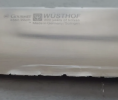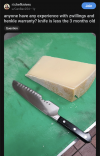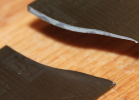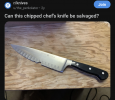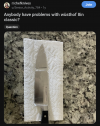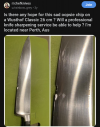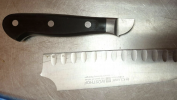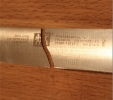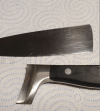-
The BladeForums.com 2024 Traditional Knife is available! Price is $250 ea (shipped within CONUS).
Order here: https://www.bladeforums.com/help/2024-traditional/
You are using an out of date browser. It may not display this or other websites correctly.
You should upgrade or use an alternative browser.
You should upgrade or use an alternative browser.
Why the hate for 4116?
- Thread starter dogstar
- Start date
- Status
- Not open for further replies.
- Joined
- Apr 24, 2023
- Messages
- 368
The main problem is that it’s used in knives costing several hundred € made by brands like Puma, and that’s just inappropriate and bad value.
Nothing against the steel in budget knives, thing is; better alternatives are available for a negligible upcharge, like 14c28n or even 440C. Why not just use those? Because it cuts a few cents into your profit margin? That's your prerogative as a company, but I also don't have to buy it.
With premium prices comes the expectation of a premium steel. Not because other steels are inadequate, but because anything else is simply bad value at the price. That's how I see it anyway. I can excuse using a lower alloy steel if the blade has been hand forged, but that's a different thing altogether.
Nothing against the steel in budget knives, thing is; better alternatives are available for a negligible upcharge, like 14c28n or even 440C. Why not just use those? Because it cuts a few cents into your profit margin? That's your prerogative as a company, but I also don't have to buy it.
With premium prices comes the expectation of a premium steel. Not because other steels are inadequate, but because anything else is simply bad value at the price. That's how I see it anyway. I can excuse using a lower alloy steel if the blade has been hand forged, but that's a different thing altogether.
Last edited:
Chronovore
Gold Member
- Joined
- Aug 29, 2019
- Messages
- 11,950
The main problem is that it’s used in knives costing several hundred € made by brands like Puma, and that’s just inappropriate and bad value.
Nothing against the steel in budget knives, thing is; better alternatives are available for a negligible upcharge, like 14c28n or even 440C. Why not just use those? Because it cuts a few cents into your profit margin? That's your prerogative as a company, but I also don't have to buy it.
With premium prices comes the expectation of a premium steel. Not because other steels are inadequate, but because anything else is simply bad value at the price. That's how I see it anyway. I can excuse using a lower alloy steel if the blade has been hand forged, but that's a different thing altogether.
This is a big part of it. If much better alternatives exist and other companies are offering them at the same or lower prices, I feel sharply disinterested.
I feel the same way about 8Cr13Mov in the current market.
DeadboxHero
Knifemaker / Craftsman / Service Provider
- Joined
- Mar 22, 2014
- Messages
- 5,442
It's more than a few cents.The main problem is that it’s used in knives costing several hundred € made by brands like Puma, and that’s just inappropriate and bad value.
Nothing against the steel in budget knives, thing is; better alternatives are available for a negligible upcharge, like 14c28n or even 440C. Why not just use those? Because it cuts a few cents into your profit margin? That's your prerogative as a company, but I also don't have to buy it.
With premium prices comes the expectation of a premium steel. Not because other steels are inadequate, but because anything else is simply bad value at the price. That's how I see it anyway. I can excuse using a lower alloy steel if the blade has been hand forged, but that's a different thing altogether.
The cost difference in materials can be several dollars per pound. The cost in abrasives can also be more significant between 4116 and 440C for example let alone adding additional processes like cold treatment
So, if you're adding an additional $3 per unit and making 10,000 units, that's $30,000.
I wouldn't call that pocket change.
I do agree though, It is nice when better steels are used
DeadboxHero
Knifemaker / Craftsman / Service Provider
- Joined
- Mar 22, 2014
- Messages
- 5,442
DeadboxHero
Knifemaker / Craftsman / Service Provider
- Joined
- Mar 22, 2014
- Messages
- 5,442
I'm no expert, but I would be surprised if that was common in all examples of 4116. Just looking at the make-up of the steel there isn't any reason that I can see that that would be the norm. To me, there doesn't seem to be a huge amount of carbon or chromium to make that an expected result. I'd be super curious to see the results if someone did some testing of multiple batches from different foundries. I would predict that Larrin's low toughness rating would improve somewhat from a larger data point.
I know this isn't going to be a real popular opinion and of course I might be completely wrong.
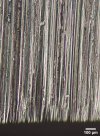
Cold Steel German 4116 steel.
Large chromium carbides seen on side of edge bevel under magnification.
The chromium carbides are harder than the surrounding matrix. The large carbides on the side of the bevel resist buffing when the edge is being finished to deburr.
4116 steel will have areas with large carbides and banding.
But why?4116 steel will have areas with large carbides and banding.
With 0.5% C + 15% Cr it seems to form massive carbides. Does it always do this? Is it something to do with the chromium to carbon ratio? Assuming this, would increasing the carbon in 4116 decrease the size of the carbides?
Why doesn't 440A or any of the 440 series, BD1N, VG10 have these massive carbides? Or any of the high chromium ingot steels.
I guess these are questions to
DeadboxHero
Knifemaker / Craftsman / Service Provider
- Joined
- Mar 22, 2014
- Messages
- 5,442
But why?
With 0.5% C + 15% Cr it seems to form massive carbides. Does it always do this? Is it something to do with the chromium to carbon ratio? Assuming this, would increasing the carbon in 4116 decrease the size of the carbides?
Why doesn't 440A or any of the 440 series, BD1N, VG10 have these massive carbides? Or any of the high chromium ingot steels.
I guess these are questions toLarrin as well if you feel like answering.
Well, It is certainly not a fluke. It is a feature of this steel in its current as supplied and processed form from the steel manufacturer.The toughness is also low in KSN charpy impact toughness testing.
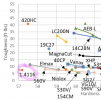
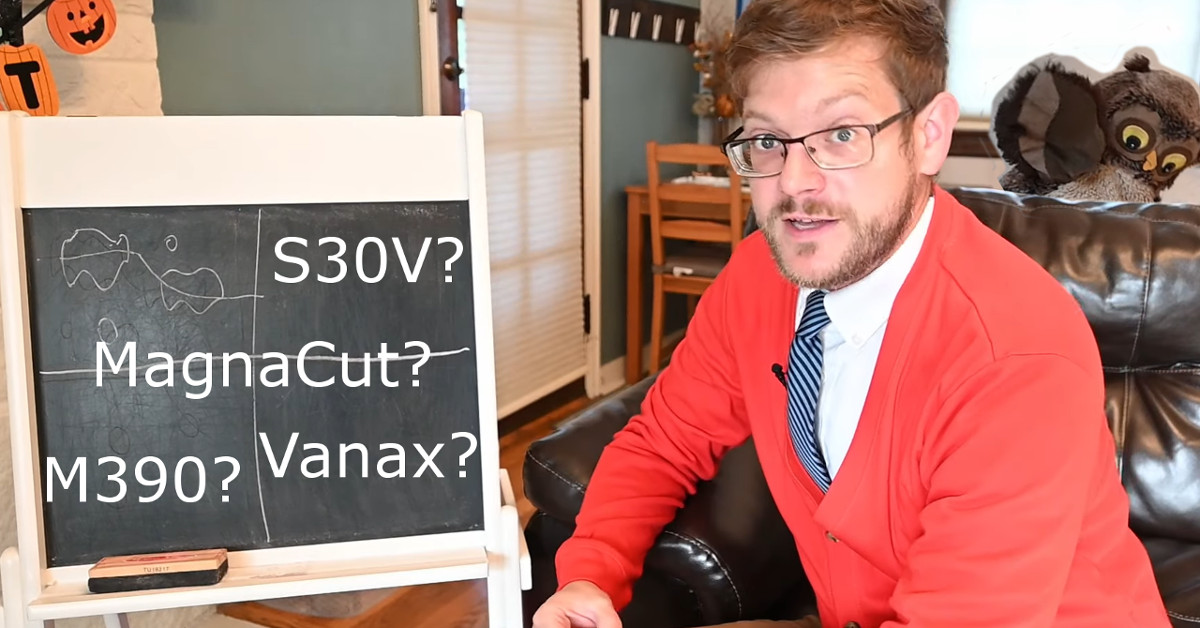
Knife Steels Rated by a Metallurgist - Toughness, Edge Retention, and Corrosion Resistance - Knife Steel Nerds
Steel Metallurgist Larrin Thomas uses tests of knife steels to rate the steels and explains the factors that control performance.
Keep in mind
Thicker geometry can mitigate the lower toughness.
Hence, why we don't see edges falling apart, most guys testing edges are testing some thick, thick edges.
Unfortunately, thicker edges also reduce cutting ability and cutting performance compared to thin edges.
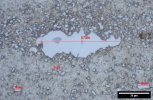
Figure 1: KSN micrograph of 4116 stainless steel. Carbides (white) measured in size.
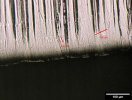
Figure 2: Cold Steel ProLite factory edge under high magnification, carbides also measured and matches up with KSN micrograph carbide sizes.
Larrin
Gold Member
- Joined
- Jan 17, 2004
- Messages
- 5,039
Those steels also have large carbides.But why?
With 0.5% C + 15% Cr it seems to form massive carbides. Does it always do this? Is it something to do with the chromium to carbon ratio? Assuming this, would increasing the carbon in 4116 decrease the size of the carbides?
Why doesn't 440A or any of the 440 series, BD1N, VG10 have these massive carbides? Or any of the high chromium ingot steels.
I guess these are questions toLarrin as well if you feel like answering.
Larrin
Gold Member
- Joined
- Jan 17, 2004
- Messages
- 5,039
Those toughness results are at different hardness values.OK, but that doesn't answer any of the questions.
Also the charpy test suggested for example that S30V is less tough despite the ratings in that article suggesting the opposite: 4116 - ~7.5 ft/lb to S30V ~6 ft/lb; toughness rating 2.5 to 4
Presumably not as large given that you have rated 440A at 3.5 compared to 2.5 in toughness? In my layman's view 440A should have a larger volume of carbides resulting in lower toughness, so I'm trying to understand what it is in the make-up of 4116 that gives it an especially low toughness rating from you.Those steels also have large carbides.
So the toughness rating in your article is more of a toughness/edge stability mix?Those toughness results are at different hardness values.
The hardnesses are in the ballpark of what you would would expect in a real world example though? In terms of toughness as you define it in your articles, a knife in 4116 at 58 HRC should be technically tougher than a knife in S30V at 60HRC, no? I have no doubt the S30V would have much better edge stability.
BTW please forgive the annoying questions, I used to drive my half my teachers mad at school trying to understand certain things.
DeadboxHero
Knifemaker / Craftsman / Service Provider
- Joined
- Mar 22, 2014
- Messages
- 5,442
Yes, it laid to rest if 1.4116 was a fine carbide steel based on its chemistry alone and if the sample used in KSN was an outlier.OK, but that doesn't answer any of the questions.
It is neither.
I answered your question above in my previous post.
"It is a feature of this steel in its current as supplied and processed form from the steel manufacturer"
You can read more about that specific subject in
"Tool Steels 4th edition" pg 28, Roberts 1980.
I believe Dr Larrin should have an interesting article coming soon to Patreon about further refining and processing AEB-L prior to austenitizing that may have some relation to this subject.
I wasn't implying it is a fine carbide steel, only that the size of the carbides seem to be double the size of anything else I have seen in different micrographs. I'm also assuming that this is why 4116 gets such a bad toughness rating(in Larrin's charts) in relation to other high chromium ingot steels that should in theory have more carbide formation and therefore worse toughness. That's what I'm trying to understand; it doesn't seem logical.Yes, it laid to rest if 1.4116 was a fine carbide steel based on its chemistry alone and if the sample used in KSN was an outlier.
It is neither.
I answered your question above in my previous post.
"It is a feature of this steel in its current as supplied and processed form from the steel manufacturer"
You can read more about that specific subject in
"Tool Steels 4th edition" pg 28, Roberts 1980.
I believe Dr Larrin should have an interesting article coming soon to Patreon about further refining and processing AEB-L prior to austenitizing that may have some relation to this subject.
If the enormous carbides are a feature of 4116 and not something you see in say 440A, then there has to be a specific reason for it. Maybe it's in the heat treatment, maybe it's in the way the particular steel manufacturer processes it or something else, I'm just interested in understanding. It doesn't seem to have the same reputation for terrible toughness in some of the thinner german kitchen knives for example at high 50's HRC.
- Joined
- Nov 13, 2013
- Messages
- 2,577
I had a cold steel in 4116 and based on that experience I avoid this steel
It did kept an edge long and was difficult to sharpen
I prefer 12c27 or 14c28n or even 8cr13mov over 4116
I don’t really mind the steel in general or how long it keeps an edge as long as it is not a pain to sharpen
In my experience 4116 is just “bad” at both edge keeping and sharpening
It did kept an edge long and was difficult to sharpen
I prefer 12c27 or 14c28n or even 8cr13mov over 4116
I don’t really mind the steel in general or how long it keeps an edge as long as it is not a pain to sharpen
In my experience 4116 is just “bad” at both edge keeping and sharpening
Matthew Gregory
Chief Executive in charge of Entertainment
- Joined
- Jan 12, 2005
- Messages
- 6,517
That’s awesome. AND as a bonus it even appears to be pre-fractured!
I’m stunned we need a micrograph for that - looks like it should be observable from space.
DeadboxHero
Knifemaker / Craftsman / Service Provider
- Joined
- Mar 22, 2014
- Messages
- 5,442
DeadboxHero
Knifemaker / Craftsman / Service Provider
- Joined
- Mar 22, 2014
- Messages
- 5,442
I had a cold steel in 4116 and based on that experience I avoid this steel
It did kept an edge long and was difficult to sharpen
I prefer 12c27 or 14c28n or even 8cr13mov over 4116
I don’t really mind the steel in general or how long it keeps an edge as long as it is not a pain to sharpen
In my experience 4116 is just “bad” at both edge keeping and sharpening
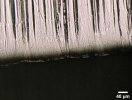
Yeah, it looks like they even had a hard time at the factory getting 4116 sharp, looks like it was a nightmare to deburr and was buffed aggressively.
I had a Henckels that had a gnarly burr on it that must have gotten passed QC.
Softer steels are notorious for stubborn burrs.
DeadboxHero
Knifemaker / Craftsman / Service Provider
- Joined
- Mar 22, 2014
- Messages
- 5,442
What's even more interesting is that none of the larger carbides survived to be shaped at the actual apex and the ones that did shattered to bits and fell out when the edge was being finished/deburred/buffed.That’s awesome. AND as a bonus it even appears to be pre-fractured!
I’m stunned we need a micrograph for that - looks like it should be observable from space.
This could show that a steel requires sufficient hardness to support larger carbides and that 55-56rc is too soft to support larger carbides leading to cracking and breaking as the supporting low strength matrix deforms.
Very fascinating.
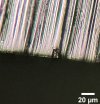
Figure 3: a 13um chromium carbide that has been shattered to bits at the apex from buffing during deburring.
- Status
- Not open for further replies.


